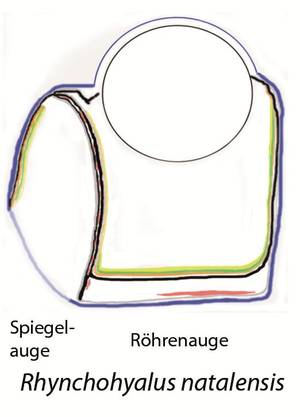Press Releases Archive
19.03.2014
All the better to see you with, my dear!
Tübingen University anatomists discover unique fisheye with two retinas – for better all-round vision in the ocean depths
The University of Tübingen’s Institute of Anatomy has discovered a fish with a previously unknown type of eye. The aptly-named glasshead barreleye lives at depths of 800 to 1000 meters. It has a cylindrical eye pointing upwards to see prey, predators or potential mates silhouetted against the gloomy light above. But the eye also has a mirror-like second lens and retina which can detect bioluminescent flashes created by deep-sea denizens to the sides and below, reports Professor Hans-Joachim Wagner in the latest Proceedings of the Royal Society.
Professor Wagner examined an 18cm long glasshead barreleye, rhynchohyalus natalensis, caught in the Tasman Sea between Australia and New Zealand, as part of an international research project. The results were unexpected – reflector eyes are usually only found in invertebrates, such as mollusks and crustaceans, although one other vertebrate, the deep-sea brownsnout spookfish or dolichopteryx longipes, also uses a combination of reflective and refractive lenses in its eyes. The light coming from below is focused onto a second retina by a curved mirror composed of many layers of small reflective plates made of guanine crystals, giving the fish a much bigger field of vision.
The glasshead barreleye is therefore one of only two vertebrates known to have reflector eyes; but significantly, although rhynchohyalus natalensis and dolichopteryx longipes belong to the same family, their reflective lenses have a different structure and appear to have developed from different kinds of tissue. That indicates that two related but different genera took different paths to arrive at a similar solution – the reflective optics and a second retina to supplement the limited vision of the conventional refractive cylindrical eye.
The prisms in the brownsnout spookfish eye grew out of a layer of pigment on the retina and the angle of the reflective crystals varies depending on their position within the mirror, but in the glasshead barreleye, the crystals are flatter and images are formed depending on the roundness of the reflective surface. “The mirror here is formed from the silvery skin of the eye, and the crystals are arrayed almost parallel to the surface of the mirror,” says Wagner. Models of the reflector showed that it is capable of throwing a bright, sharp image onto the retina below. “Obviously, a broad field of vision is an advantage even at great depths if similar structures develop independently to ensure it.”

Diagram of a longitudinal section of the rhynchohyalus natalensis eye: The eye is cylindrical with a conventional round lens on top; light from above hits the main retina (green). Bioluminescence enters through a cornea on the left and hits the secondary, silvery lens, to be focused on the second retina (yellow). The fish can therefore see objects above it with its conventional cylindrical eye, and detect other deep-sea creatures to the side and below via the reflector eye looking sideways. Diagram: H.-J. Wagner
 | Diagram of a longitudinal section of the rhynchohyalus natalensis eye: The eye is cylindrical with a conventional round lens on top; light from above hits the main retina (green). Bioluminescence enters through a cornea on the left and hits the secondary, silvery lens, to be focused on the second retina (yellow). The fish can therefore see objects above it with its conventional cylindrical eye, and detect other deep-sea creatures to the side and below via the reflector eye looking sideways. Diagram: H.-J. Wagner |
|---|
Publication:
Julian Partridge, Ron Douglas, Justin Marshall, Wen-Sung Chung, Thomas Jordan, Hans-Joachim Wagner: “Reflecting optics in the diverticular eye of a deep-sea barreleye fish (Rhynchohyalus natalensis).” Proceedings of the Royal Society B, 19. März 2014.
Contact:
Prof. Dr. Hans-Joachim Wagner
University of Tübingen
Faculty of Medicine
Institute of Anatomy
Phone: +49 7071 2973019
<link>hjwagner[at]anatu.uni-tuebingen.de
